A road legal prototype Mercedes-Benz has managed to travel 422 miles on one charge, 77 miles further than any other car previously tested.
The VISION EQXX uses less than 10 kWh of electrical energy to travel 100 km, equating to traveling 6 miles on 1 kWh of electrical energy, or the equivalent to the golden figure of 1 litre per 100 kilometres (235 mpg US or 282 mpg UK).
“Just one-and-a-half years ago we started this project leading to the most efficient Mercedes-Benz ever built – with an outstanding energy consumption of less than 10 kWh per 100 kilometres. It has a range of more than 1,000 kilometres on a single charge using a battery that would fit even into a compact vehicle.” Ola Källenius, chairman of the Board of Management of Daimler AG and Mercedes-Benz AG said.
The technology programme behind the VISION EQXX will enable future Mercedes-Benz models, using sustainable materials throughout to cut its carbon footprint and including advances across the entire electric drivetrain and lightweight to improve its efficiency.
The drivetrain in particular has achieved a milestone in efficiency; rated at 95 per cent efficiency compared to 30 per cent from even the most efficient ICE drivetrain or around 50 per cent from an average (human) long-distance runner. The vehicle even includes ultra-thin solar roof panels that feed the battery system for up to 25 km of extra range.
The ideas of sustainability run throughout the production of the vehicle too, by using MyloTM and Deserttex, leather alternatives made from mycelium and cactus-based materials respectively, the new materials avoid plastics of animal products in the interior. The carpets are made from bamboo fibre and there is extensive use of recycled waste materials, such as the recycled PET bottles, and the interior also features UBQ material, a sustainable plastic substitute made from household and municipal landfill waste.
The looks might not be to everyone’s taste, but in engineering terms, it is the direction of travel for future EVs.
Latest News
-
Investment firm hands £650,000 to charities supporting young people
-
East Midlands Railway links with charity to improve travel for autistic people
-
Hotel chain to support carers' mental health
-
Sainsbury’s and charity think tank link up to better understand food insecurity
-
Access Group raises £1.55m for nine charities across the world in a year
-
PureGym raises over £100,000 for heart health charities
© 2019 Perspective Publishing Privacy & Cookies









Recent Stories